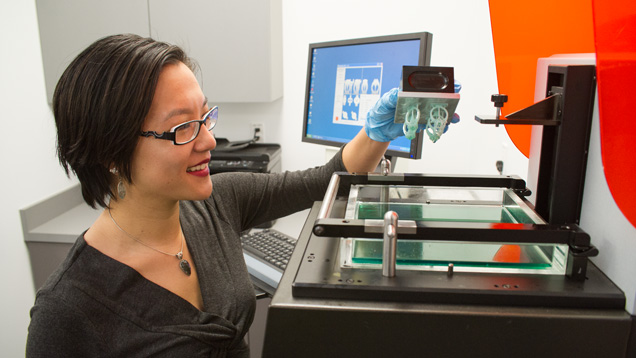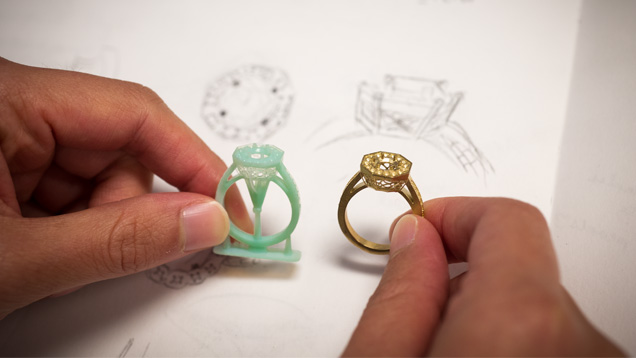3-D Printing: GIA Equips Students for a ‘Technology Revolution’
July 24, 2015

The incredible potential of 3-D printing is all over the news and our social media feeds. The applications are mind-boggling and their benefits game-changing for industries ranging from medicine to food to architecture – and to jewelry design and manufacturing, where time, precision and cost-effectiveness are highly valued.
These 3-D printing applications are part of a larger movement that has already begun to change the status quo, says Steve Workman, an instructor who uses the printers in GIA’s Jewelry Design and Technology (JDT) program.
“Something remarkable happened to jewelry design and manufacturing in the past few years,” he says. “It underwent a technology revolution powered by Computer-Aided Design (CAD) software and Computer-Aided Manufacturing (CAM) hardware, such as 3-D printers.”It’s [3D printing] the way the industry is going and it’s what every company wants, from huge manufacturers to the mom-and-pop stores.
3-D Printing: What is It, Exactly?
As much as 3-D printing has made headlines, many people still don’t understand what it is or how it works. It can be helpful to consider the broader context of 3-D printing through the terms subtractive and additive manufacturing.
Imagine a Renaissance artist gazing at a huge slab or marble, considering how he might create art out of the rough stone. That’s how Mike Magee, the manager of GIA’s Jewelry Manufacturing Arts (JMA) program, likes to explain subtractive manufacturing.
“If you think of it as starting with a big block of something and whittling away until what you want is revealed – like Michelangelo looking at that marble and seeing what is living inside of it – that’s subtractive manufacturing,” he says.
Additive manufacturing, including 3-D printing, starts with nothing at all: It involves creating a piece of jewelry, a pancake, a prosthetic arm or an apartment building from the ground up, one tiny layer at a time.
“These layers are down to 30 microns thick, typically,” Magee says. “That’s 3/100ths of a millimeter, for perspective.”
The 3-D printers, a type of CAM hardware, use additive technology to print objects like chains or mesh directly into 18K gold.
“That’s still pretty rare in our industry, though,” Magee says. “In other industries it’s more developed, but this is still very new to the jewelry world. Most of the time with 3-D printing, we’re creating a model – an object that’s going to be cast – like a ring or larger object that doesn’t have quite so many moving parts, and we’re creating it in a material that works reasonably like wax when it comes to the casting process.”

GIA Instructor Steve Workman assists Jewelry Design Technology students in supporting their CAD models as they prepare them for building on the 3-D printer. Photo by Kevin Schumacher
More Efficiency and Accuracy, Less WasteThere’s no doubt that Michelangelo’s famous David is an artistic masterpiece, but the artist also wasted a lot of costly Tuscan marble every time he took a chisel to the block.
That’s one of the greatest benefits of utilizing 3-D printing or any additive technologies - there’s less material waste. CAD technologies already make it possible to more quickly create proofs of concept, precise mirror images, modifications and customizations. The new 3-D printers only enhance that.
“In the past, manufacturers used rubber molds to make duplicates of the original master model,” Workman says. “If variations on that model were needed, the model maker would have to create a whole new model. With CAD software, changes can be made with clicks of a mouse, and the new model can be printed on demand on a CAM machine such as a 3-D printer. These printers enable manufacturers to print resin prototypes of the CAD model that can be easily cast.”

Michelle Loon removes the build platform from the 3-D printer. Photo by Kevin Schumacher
Kimberly Overlin, GIA’s dean of students and an alumna of the Institute’s graduate gemology and graduate jeweler programs, notes that it makes the consumer trend of wanting to “customize everything” possible.“What was once potentially cost-prohibitive is now affordable and easy for us to do,” she says.
Magee adds that a “much more effective economy of scale” is another significant benefit. Since a 3-D printer typically allows printing more than one object at time, a manufacturer could potentially print 16 rings in six to eight hours instead of one in the same time period.
As a form of additive manufacturing, 3-D printing also “has the advantage of being able to create much more complicated geometry than you get with subtractive manufacturing,” he says.
“You can create hollow spots much more easily. On most 3-D printers, you are not limited by the geometry of the piece itself - there are no tools to get into a hollow spot, there is no drill you have to get into a weird angle.”

Jewelry Design technology students compare the visual communications of their designs to the 3-D-printed and cast prototypes. Photo by Kevin Schumacher
Equipping Students with In-Demand SkillsGIA utilizes 3-D printing in its 26-week JDT program, offered in Carlsbad and, in 2016, at the Institute’s New York campus. The program, which teaches design, engineering and jewelry manufacturing concepts, gives students hands-on experience in the creation, rendering and prototyping of designs with CAD software and CAM hardware, including 3-D printers.
Instructors, including Workman, Shaun Peterson, Darla Alvarez, Doug Hall and Kelly Borrello begin with the basics.
“We start off with a very simple ring,” Magee says. “Students create very simple geometry and supports for that, and gradually create more and more complex geometry and have to support it and print those pieces, as well. Eventually, they’re designing their own pieces, and by the end of the program they’ve got the skills to look at any object and figure out how they’re going to get it to successfully print and cast.”
Laurie Bailyn, GIA’s manager of JMA research, development and production, says new markets are opening up all the time for these technologies.
“Some large corporations, like Hewlett-Packard and Autodesk, that weren’t previously in this market are expressing interest in developing hardware or software for 3-D printing in jewelry,” she says.
Overlin concurs.
“CAD/CAM technologies like 3-D printing have been moving into jewelry for the past several years,” she says. “It’s the way the industry is going and it’s what every company wants, from huge manufacturers to the mom-and-pop stores. There is a much greater need for qualified people who can utilize them – the more graduates know and the more marketable they are, the better.”
Magee expects that GIA graduates will be well-equipped to meet the challenges and opportunities of the ever-evolving design and manufacturing market.
“The jewelry design technology class is going to give you a front-row seat to the tremendous change that’s going on in our industry,” he says. “It’s going to give you experience with the latest 3-D printers, the latest in technology – and how that is changing the entire marketplace.”
About the Author
Jaime Kautsky, a contributing writer, is a GIA Diamonds Graduate and GIA Accredited Jewelry Professional and was an associate editor of The Loupe magazine.



